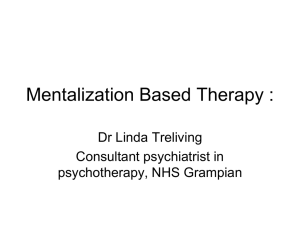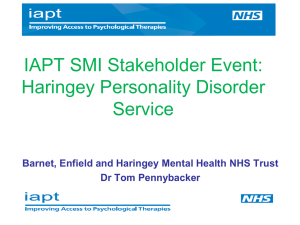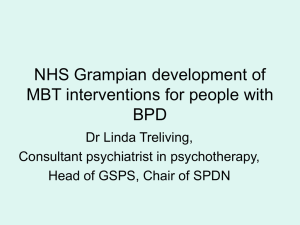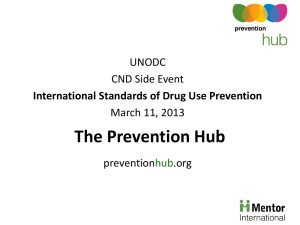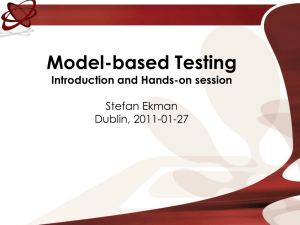An evaluation of the HUB Program - Scottish Personality Disorder
advertisement
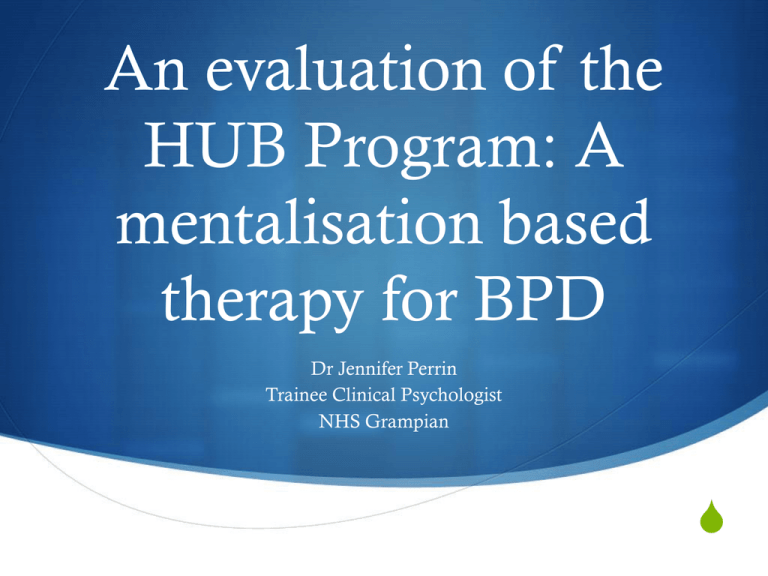
An evaluation of the HUB Program: A mentalisation based therapy for BPD Dr Jennifer Perrin Trainee Clinical Psychologist NHS Grampian S Outline S What is mentalisation and MBT? S What’s the evidence for MBT? S Brief History and introduction to the HUB program S Aims of the study S Study Protocol What is mentalization ? - Many ways to define it.. - To be able to hold someone else’s mind in your mind - To implicitly and explicitly interpret the actions of oneself and others as meaningful on the bases of intentional mental states. - Develops as part of of our attachment relationships. Why is mentalizing important? S It influences our understanding of others and ourselves S Allows us to interpret intentions and meaning to human behaviour. Borderline Personality Disorder S Thought to develop through a complex relationship between genetics and adverse childhood events. S Traditional view: genetic factors interact with experiences of early adverse events to cause emotional dysregulation and impulsivity, which in turn could lead to dysfunctional behaviours such as self-harm and psychosocial conflicts and deficits. BPD: attachment theory S Based on attachment theories put forward by Bowlby and Winnicott. S BPD development: attachment system is disorganized in BPD resulting in the disorganization the individual’s selfstructure. This disrupted attachment system inhibits the development of mentalisation. S Disruption often due to childhood abuse or other psychological trauma. Disruption of mentalisation S 4 hypothesized routes: S 1) the child as a defense inhibits this process to protect themselves from the abuse S 2) early stress experienced by the child has an impact on the arousal system, which is observed as inhibition in the orbitofrontal cortex (the area of the brain thought to be involved in metalizing) . S 3) the trauma arouses the attachment system leading the child to search for attachment security may lead to further abuse if the perpetrator is an attachment figure. S 4) the child in attempt to cope with the abuse may try to identify with the abuser and as a result may internalize the intent of the abuser, which can lead to feelings of self-hate. BPD and mentalising S Reported that between 40-71% on inpatients with BPD have suffered from childhood abuse or neglect (Lieb et al 2004; Zanarini et al, 1997; Ogata et al, 1990; Shearer et al, 1990). MBT interventions S Developed by Bateman and Fonagy S Manualised intervention S Original structure: Assessment – MBT-I – MBT (group plus individual therapy). S MBT-I is 12 sessions covering such topics emotions and emotion regulation, importance of attachment, mentalisation S MBT group = a training ground for mentalisation. Therapist’s stance Yes S Not knowing S Active questioning (curiosity) S Continually questioning both the patient’s and your own mental state S It’s ok to be wrong! NO MBT principles S Keep it simple! S Focused on affect S Focused on the patients mind S Keep it related to current events S De-emphasize unconscious concerns MBT interventions Supportive/empathic Clarification, elaboration, challenge Basic metalizing: affect and affect focus Mentalizing the relationship Evidence for MBT S Original RCT by Bateman and Fonagy (2008) S Compared MBT with structured clinical management S Those in the MBT group showed a faster decline in symptom distress as well as suicide attempts and hospitalization. S Symptom Distress measured mainly by the SCL-90. RCT 8-year follow-up S Bateman and Fonagy followed-up the same patients from the RCT for 8 years. S Those in the MBT group had less suicide attempts, fewer hospital admissions, and were taking less medications over the 8 years since the intervention than the treatment as usual group. S Those in the MBT group were more likely to be employed or in school in the years following treatment Further studies of MBT S Jorgensen and colleagues (2013) found that those receiving an MBT intervention were more likely to achieve “recovery” and were significantly less distressed by psychiatric symptoms than patients receiving a supportive group intervention. S Bales and colleagues (2012) also found that MBT was an effective intervention and while reducing suicide, self-harm and care consumption, it also increased interpersonal functioning. Cochrane Review of treatment for BDP (2013) S Most research done on Dialect Behaviour Therapy (DBT) S MBT interventions are effective at treating core symptoms of BPD S Core finding = More research is needed!!!! The HUB Program S Originated in Aberdeen out of necessity to offer treatment for BPD and the closure of the therapeutic community. S The HUB combined aspects of the therapeutic community and MBT, which was at the time emerging as an effective treatment. S Unique as it is a group only approach. HUB set up S Once a week for 24 weeks S Full day from 10 until 3 S Morning group is psychoeducation, then lunch and an afternoon group MBT Morning Schedule Psycho education 1 2 3 4 5 SCID 6 7 8 9 10 11 MBT skills 12 13 14 15 16 17 18 19 20 21 22 23 24 The Study S Aim: A pilot investigation into the effectiveness of the HUB program. S Main question: Does completing the HUB program decrease within-participant psychological distress? S Secondary questions: Are there within-participant changes in relationship style or relationship problems after completing the HUB program? What is the subjective experience of the HUB? Study Design S Mixed method within-participant design S Includes both qualitative and quantitative measures S Interviews will take place pre-HUB and then post-HUB S Looking to recruit 10-15 patients Study/HUB flow chart Referral made to psychotherapy Patients sent SCL-90 to complete and information on HUB Program Sending back = opting in 1 on 1 appointment with clinician: eligibility, CTQ and PDQ4 Suitable for HUB = formulation session Pre-Hub group session - recruitment Includes: AAP Pre-HUB interview IIP SAS-SR Includes: AAP IIP SAS-SR SCL-90 Interview HUB program Week 23 – post HUB interview The Symptom Checklist (SCL90) S Routine measure S Self-report questionnaire scored on a five-point scale (0-4) assessing rate of symptom occurrence over the last 7 days. S Subscales include: somatization, obsessive-compulsive, interpersonal sensitivity, depression, anxiety, hostility, phobic anxiety, paranoid ideation, psychoticism. S Mean score = Global Severity Index Childhood Trauma Questionnaire (CTQ) S Self-report questionnaire where you are asked to rate the truth of each statement from never true to very often true. S CTQ covers emotional, physical and sexual abuse as well as emotional and physical neglect. Personality Diagnostic Questionnaire (PDQ-4) S Routine measure S 99 true/false questions that produce scores for the 10 different diagnoses. S Score of 50 or greater = increased likelihood of a personality disorder. Adult Attachment Projective (AAP) S Adult Attachment Projective S Shown 8 pictures and asked to tell a story S Responses allows classification into 4 attachment styles Inventory of Interpersonal Problems (IIP) S 32 questions S examines what types of interpersonal problems an individual may be experiencing and the levels of distress associated with these problems S Used by Bateman and Fonagy in their RCT of MBT Social Adjustment Scale (SAS) S Examines interpersonal relationships, whether any friction exists in these relationships, feelings and satisfaction at work and what if any social and leisure activities are undertaken with any family members. S Again used by Bateman and Fonagy in their RCT Qualitative Interview S Asks participants about their subjective experience of the HUB program. S Will include questions such as: S What did you like about the program? S What is the main thing you are taking away from your time in the HUB group? S If you could make any changes to the program what would they be? Planned analyses S Quantitative: S Paired t-tests between pre and post scores on the SCL-90, IIP and SAS S Are there significant decreases? S Correlations between attachment styles and outcome measures S Qualitative: S Thematic analysis to highlight common themes among responses Potential Outcomes S Provide the basis for a larger scale RCT of the HUB program. S Potential to refine the program based on responses from the interviews. S Add to the evidence base on treatment for BPD. S THANK YOU AND ANY QUESTIONS????


